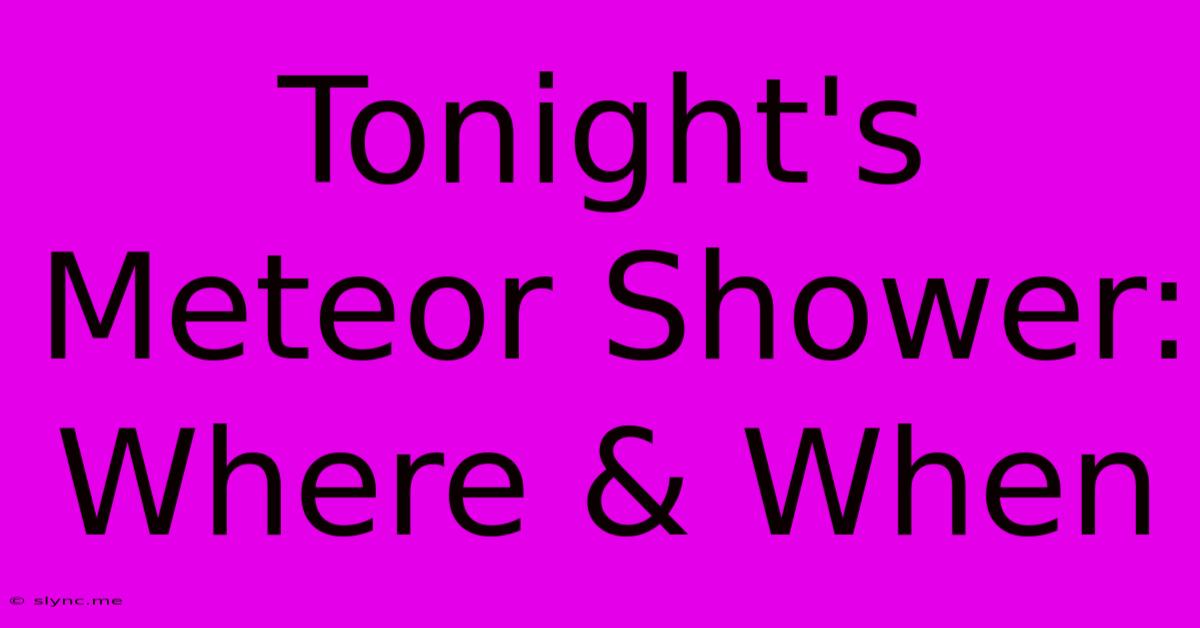Tonight's Meteor Shower: Where & When

Discover more detailed and exciting information on our website. Click the link below to start your adventure: Visit Best Website Mrs.Amykhan. Don't miss out!
Table of Contents
Tonight's Meteor Shower: Where & When to Catch the Show
Are you ready for a celestial spectacle? Tonight's meteor shower promises a dazzling display, and we've got all the information you need to catch the show. Whether you're a seasoned stargazer or a curious newcomer, this guide will help you find the perfect viewing spot and maximize your chances of witnessing this breathtaking event.
Understanding Tonight's Meteor Shower
First things first: which meteor shower are we talking about? Knowing the specific shower (e.g., Perseids, Geminids) helps determine its radiant point – the point in the sky from which the meteors appear to originate. This information is crucial for optimal viewing. Check reliable astronomy resources like NASA or your local planetarium website to confirm the shower's name and peak time. These resources usually provide detailed predictions including the expected zenithal hourly rate (ZHR), which represents the number of meteors you might see under ideal conditions.
Where to Watch: Finding the Perfect Viewing Spot
Light pollution is the biggest enemy of meteor shower viewing. The brighter the sky, the fewer meteors you'll see. To maximize your experience:
Escape the City Lights:
- Rural Areas: The further away from urban areas you are, the darker the sky will be. Head to the countryside, a national park, or a remote area with minimal light pollution.
- High Altitude: Higher elevations offer clearer skies with less atmospheric interference.
- Open Spaces: Find a location with a wide, unobstructed view of the sky. Avoid trees, buildings, and hills that could block your view.
Consider these factors:
- Weather: Check the weather forecast. Cloudy skies will completely ruin your viewing experience.
- Safety: Choose a safe and accessible location. Let someone know where you're going and when you expect to be back.
- Comfort: Bring a comfortable chair, blanket, or sleeping bag. Meteor showers can last for hours, and you'll want to be comfortable.
When to Watch: Timing is Everything
The peak time of a meteor shower is usually a short window, often just a few hours. Again, consult reliable astronomy resources for the precise peak time in your location. Remember that meteor showers are often active for several nights before and after the peak, although at a lower rate.
Tips for Maximizing Your Viewing Time:
- Arrive Early: Give yourself plenty of time to get settled and let your eyes adjust to the darkness.
- Be Patient: It takes time for your eyes to adapt to the night sky. Don't expect to see meteors immediately.
- Look Around: While meteors will appear to radiate from the shower's radiant point, they can appear anywhere in the sky. Keep your eyes moving.
What to Bring: Essential Gear for Meteor Shower Viewing
- Red Flashlight: A red light preserves your night vision better than a white light.
- Blanket or Sleeping Bag: It can get cold at night, even in summer.
- Chair or Mat: Make sure you're comfortable.
- Snacks and Drinks: Keep yourself energized for the show.
- Star Chart (Optional): A star chart can help you identify constellations and other celestial objects.
Beyond the Visual Spectacle: More Than Just Meteors
Don't forget to take some time to appreciate the beauty of the night sky beyond the meteor shower. Look for constellations, planets, and even the Milky Way. This is a chance to reconnect with nature and marvel at the universe's grandeur.
Tonight's meteor shower offers a unique opportunity to experience the wonder of the cosmos. By following these tips, you can significantly increase your chances of witnessing a truly unforgettable celestial event. So, get ready to look up and be amazed!

Thank you for visiting our website wich cover about Tonight's Meteor Shower: Where & When. We hope the information provided has been useful to you. Feel free to contact us if you have any questions or need further assistance. See you next time and dont miss to bookmark.
Also read the following articles
| Article Title | Date |
|---|---|
| Usi Rezultati 5 Turu Ligi Konferentsiy | Dec 13, 2024 |
| Narodni Zvichayi 13 Grudnya Svyato Andriya | Dec 13, 2024 |
| 13 Grudnya Narodni Prikmeti Ta Zaboroni | Dec 13, 2024 |
| Istoriya Ta Data Dnya Sukhoputnikh Viysk Zsu | Dec 13, 2024 |
| Onovleniy Grafik Vidklyuchen Vid Lvivoblenergo | Dec 13, 2024 |
